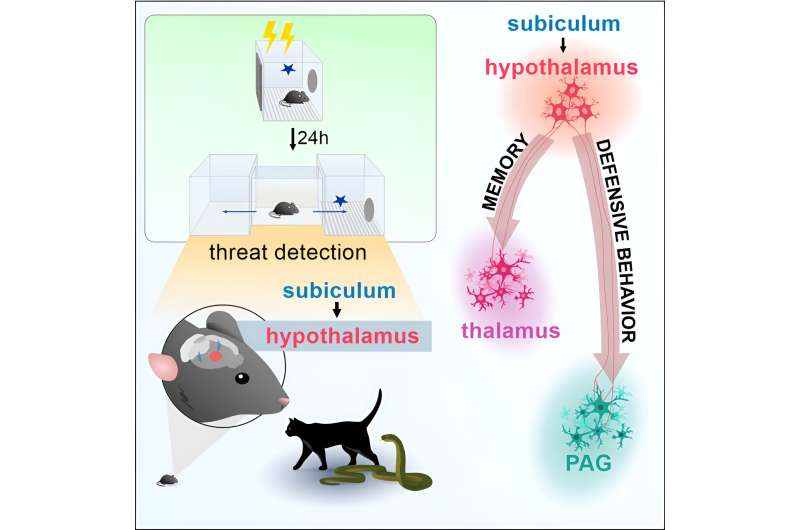This article has been reviewed according to Science X's editorial process and policies. Editors have highlighted the following attributes while ensuring the content's credibility:
fact-checked
peer-reviewed publication
trusted source
proofread
Researchers map brain circuits that signal immediate danger and create memories to help avoid threats

An article published in the journal Current Biology describes experiments that mapped a brain circuit responsible for instantly detecting threats and forming memories of fear.
"We were interested in locating a brain region associated with fear signaling and finding out how it could identify environments previously related to physical or predatory threats, such as a place where the individual underwent an aversive physical stimulus," said Newton Sabino Canteras, full professor in the Department of Anatomy at the University of São Paulo's Biomedical Sciences Institute (ICB-USP) in Brazil and last author of the article.
The hippocampus is known to be involved in spatial navigation and orientation. This brain region also detects threats from the environment. Anything dangerous leaves a mark there so that it is possible to compute the precise location of the threat, Canteras explained. A pivotal structure closely tied to the hippocampus is the subiculum.
"The subiculum is basically the star of the show. It transfers information linked to environmental threats to the hypothalamus. We set out to investigate how it behaves when the animal faces an environment previously associated with an aversive stimulus," he said.
The researchers used fiber photometry to observe activity in the subiculum. "We inserted a virus that expresses a calcium-sensitive protein capable of registering cellular activity. It emits fluorescence in response to cellular activity," Canteras said.
The behavioral paradigm they used consisted of habituating a mouse to an apparatus with two boxes connected by a corridor. Initially, the mouse was restricted to one box and received aversive physical stimuli (electric shocks to its paws). On the following day, it was placed in the apparatus so that it could avoid the aversive box.
"In this type of test, the animal stretches and sniffs, moves one way and another, but doesn't go back into the box where its paws were shocked. It displays what we call avoidance behavior," he said.
Photometry analysis focusing on the dorsal premammillary nucleus (PMd), a critical interface of the neural circuit investigated, showed that the PMd becomes particularly active when the animal approaches and avoids the threatening source.
"It's a very clear threat detector and interacts dynamically with the source. If the mouse turns its back on the source, the PMd isn't activated, but if it looks at the source or moves close to it, the PMd 'sounds the alarm." That's one of the key findings of the study," he said.
The researchers then inactivated the PMd with a widely used chemogenetic technique known as DREADDs, short for designer receptors exclusively activated by designer drugs.
"We injected a virus that expressed a receptor [the protein hM4Di] which silenced the PMd in the presence of a specific drug. The drug prevented the cells from firing. They resumed normal functioning as soon as the drug was withdrawn.
"When the PMd was silenced in this way, the animal drastically reduced its defensive response. Instead of avoiding the threatening box, it went back in as if it were a harmless environment—as if nothing had happened," he said.
They concluded that PMd inactivation influenced both contextual fear responses and reconsolidation of fear memory. Thus, after PMd inactivation, the animal considers the environment safe and navigates it as if there were no risks on the following day.
Next they investigated the functional roles of the PMd's main targets in the nervous system: the periaqueductal gray or PAG (in the brainstem) and the ventral anteromedial thalamus (in the thalamus).
"There's a technique whereby I can specifically inactivate the projection that goes to the brainstem or to the thalamus. I insert into the PMd a virus that expresses a protein acting as a light-sensitive chlorine channel. When I light up the terminal fields, these terminations are silenced and I can manipulate a specific projection pathway," Canteras said.
The researchers observed that while inactivation of the PAG projection pathway reduced the animal's defensive behavior, it responded well to fear on the following day, showing that fear memory was unaffected.
"Expression of behavior is affected, but not fear memory reconsolidation. On the other hand, inactivation of the thalamus pathway has practically no immediate effect but significantly affects fear memory reconsolidation," he said, adding that both events are mediated mainly by different nucleus projection sites.
The co-first authors of the article are Juliette Viellard (ICB-USP and Institute of Neurodegenerative Diseases, Bordeaux University, France), and Fernando Melleu (ICB-USP).
The other co-authors are Alicia Tamais, Alisson de Almeida, Carolina Zerbini, Juliane Ikebara, Karolina Domingues, Miguel de Lima, Simone Motta, (all ICB-USP); and Fernando A. Oliveira (Cellular and Molecular Laboratory, Center for Mathematics, Computation and Cognition, Federal University of the ABC).
More information: Juliette M.A. Viellard et al, A subiculum-hypothalamic pathway functions in dynamic threat detection and memory updating, Current Biology (2024). DOI: 10.1016/j.cub.2024.05.006





















